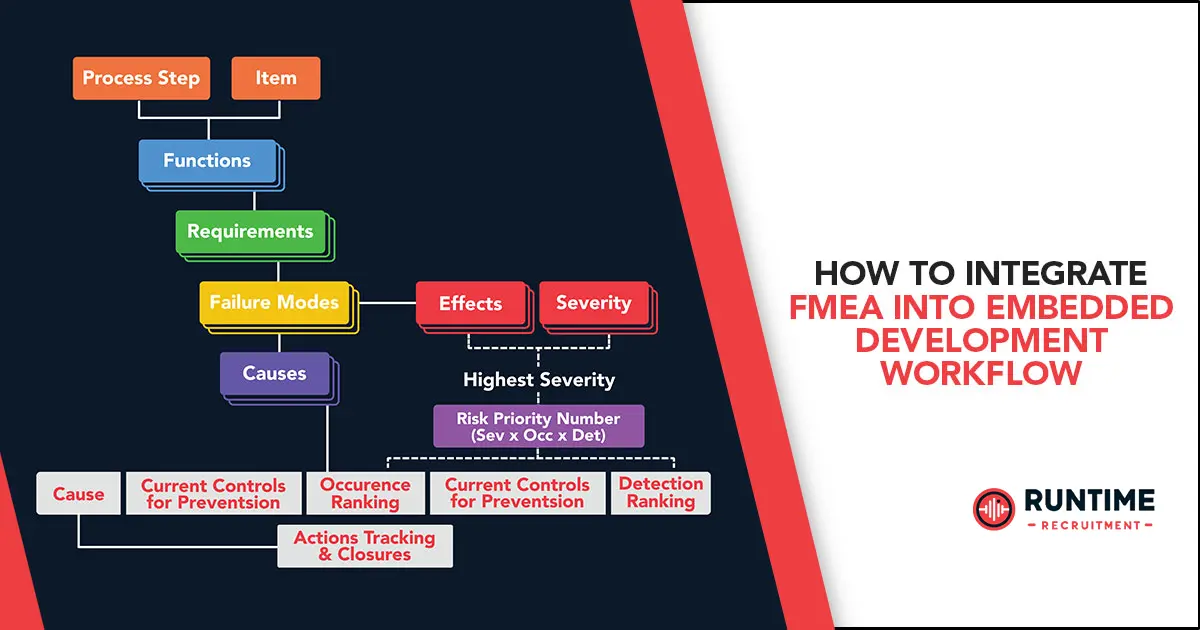Failure Mode and Effects Analysis (FMEA) is a methodical and proactive approach used to identify potential failures within a system, analyze their impact on overall functionality, and implement preventive measures. In the embedded systems industry, where reliability and safety are crucial, FMEA plays a critical role in ensuring the strength of developed products. By integrating FMEA into the development process, engineers can proactively reduce risks, enhance system design, and ultimately create more dependable embedded systems. Let’s discuss this in more detail.
FMEA Process Breakdown
The FMEA process can be broken down into several key steps:
- System Definition: Clearly define the scope of the FMEA analysis, including the specific embedded system under consideration and its intended functionality. Identify all relevant components, both hardware and software, that contribute to the system’s operation.
- Identification of Failure Modes: For each component within the system, brainstorm and document all potential failure modes. This requires a deep understanding of the component’s behavior and limitations. In the context of embedded systems, failure modes could include hardware component malfunctions (e.g., sensor failure, memory corruption), software bugs (e.g., logic errors, infinite loops), or communication breakdowns between components.
- Effects Analysis: Analyze the consequences of each identified failure mode on the overall system functionality. Consider both direct effects (immediate loss of functionality) and cascading effects (how the failure propagates to other parts of the system).
- Severity Ranking: Assign a severity ranking to each failure mode based on the impact it has on the system. This ranking typically uses a scale (e.g., 1-5) with higher values representing more critical failures that could lead to safety hazards, data loss, or complete system shutdown.
- Occurrence Ranking: Estimate the likelihood (probability) of each failure mode occurring during system operation. This ranking considers factors such as component reliability data, historical failure rates, and environmental stresses the system might encounter.
- Detection Ranking: Evaluate the effectiveness of existing controls (hardware/software checks, monitoring systems) in detecting the occurrence of each failure mode. A low detection ranking indicates a higher risk, as the failure might go unnoticed and lead to more severe consequences.
- Risk Priority Number (RPN): Calculate the RPN for each failure mode by multiplying the severity, occurrence, and detection rankings. This metric provides a quantitative assessment of risk, allowing engineers to prioritize mitigation efforts towards the failure modes with the highest RPNs.
- Recommended Actions: Based on the identified risks and RPNs, propose corrective or preventative actions to mitigate the effects of potential failures. This could involve implementing hardware redundancy, adding software error checking routines, or incorporating system-level safety features.
Integration into Development Workflow
FMEA can be effectively integrated into different stages of the embedded development lifecycle. Here are some key points to consider:
- Early Design Phase: Performing FMEA during the initial design stages allows engineers to identify and address potential issues early on, when design changes are easier to implement. This proactive approach can significantly reduce development costs and time spent fixing problems later in the cycle.
- After Code Reviews: Following code reviews, FMEA can be used to specifically target software-related failure modes. Analyzing the code for potential bugs and their effects on system functionality can help identify areas where additional testing or code hardening is necessary.
- Throughout Development: FMEA is an iterative process. As the design evolves and new components or functionalities are added, the FMEA analysis should be revisited and updated to reflect the changes. This ensures that potential risks associated with new additions are identified and addressed.
The results of the FMEA analysis should be documented and communicated effectively within the development team. This allows engineers to make informed design decisions, prioritize verification and validation activities (testing), and ensure that mitigation strategies are implemented effectively. Tracking the impact of FMEA findings throughout the development process allows for continuous improvement and ensures that identified risks are addressed.
Tools and Techniques
Several tools and techniques can aid in conducting FMEA for embedded systems:
- FMEA Software: Dedicated FMEA software applications can streamline the process by providing templates for data collection, automated RPN calculations, and visualization tools for risk prioritization.
- Fault Tree Analysis (FTA): FTA is a complementary technique that helps visualize the logical relationships between component failures and their resulting system effects. This can be particularly valuable for complex systems with cascading failure modes.
- Hardware Reliability Prediction Tools: Industry-standard tools and databases can provide valuable data on component failure rates, which can be used to inform the occurrence ranking during the FMEA process.
When selecting tools, it’s important to consider the complexity of the embedded system, the size of the development team, and the desired level of automation.
Wrapping Up
By integrating FMEA into the development workflow, engineers can proactively identify and address potential failures in embedded systems. This systematic approach promotes the development of robust, reliable, and ultimately safer embedded systems. The use of FMEA tools and techniques, combined with effective communication and documentation practices, empowers development teams to make informed design decisions and prioritize risk mitigation efforts. By prioritizing safety and reliability from the outset, FMEA plays a crucial role in ensuring the success of embedded system development projects.
References
- Society of Automotive Engineers – “Failure Modes and Effects Analysis (FMEA) – FMEA Reference Manual” (reference industry standard for FMEA)
- International Council on Systems Engineering – “INCOSE SE Handbook: A Guide to Systems Engineering” (Chapter 15: Risk Management)
National Institute of Standards and Technology (NIST) – “Special Publication 810: An Update to the Electronics Technicians’ Handbook” (Chapter 3: Failure Modes, Mechanisms, and Effects Analysis)









